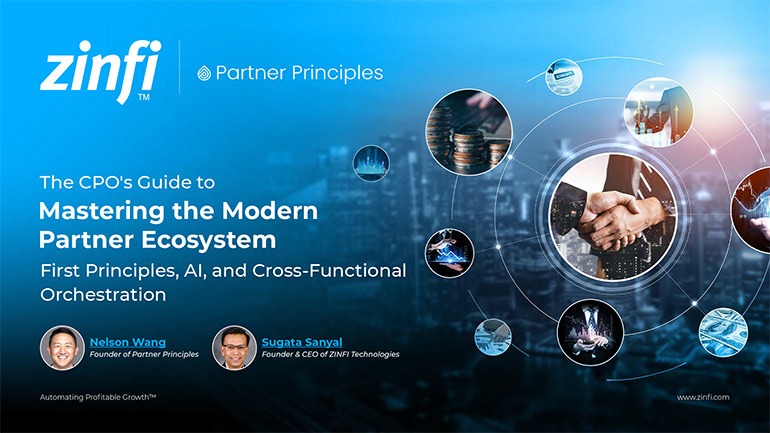Best Practices Articles

The Evolution of Through-Channel Marketing Automation
Over the past decade, a whole new category of business process automation software has evolved. We call this category through-channel marketing automation or TCMA. Forrester Research first coined this term about 10 years ago. Since then, multiple technology providers—small and large—have entered the TCMA space.
As it happens, ZINFI was recently recognized by Forrester as a leader of through-channel marketing automation solutions. Forrester identified the 15 most significant vendors in the current marketplace by researching, analyzing and scoring solution providers on a set of 25 core criteria. ZINFI was recognized for its “wide set of integrated marketing tools such as search, social, syndication, email, event, and microsites that can be put together in a single- or multi-touch campaign.” ZINFI was also praised for its “strong cross-functionality,” which brings together components like marketing and sales assets, market development funds (MDF)/co-op management, reporting and business intelligence.
We have been active in this market for over a decade now, and we have some informed ideas about how it will look in the future. In this article, we will provide a quick overview of how through-channel marketing automation market has evolved, and explore where the market may be headed.
What is through-channel marketing automation? Who needs it, and why? TCMA refers to a category of marketing automation tools that are used both by vendors who market and sell their solutions via a partner network and by various types of resellers of the vendor’s products and services. A reseller could be an insurance agent, an automotive dealer, an equipment reseller or a franchise. When a primary brand wants to reach end buyers and needs a secondary or a tertiary organization to act as a distribution channel (i.e., a sales channel), the primary brand wants to make sure its messaging and positioning are properly communicated and maintained when its agents (resellers, etc.) market its solutions to end users. Through-channel marketing automation tools can help brands manage this work in a highly efficient and cost-effective manner, and they can also help partner organizations execute on various tactics and strategies as they market and sell the brand’s solutions.
The total addressable market for through-channel marketing automation (TCMA) software is massive and growing rapidly. Forrester estimates that more than 75% of worldwide commerce flows through some kind of indirect sales or distribution channel reselling the products and services of a primary brand. Forrester is predicting that the TCMA software market will grow to $1.18 billion by 2023 (a compound annual growth rate of more than 25%), and estimates that another $1.3 billion will be generated in services at these vendor firms.
If you include the tens of thousands of digital marketing agencies, which Forrester expects to generate $2 billion in services revenue by 2023, you have a $4.5 billion ecosystem within five years. Already today there are more than 6 million end users of TCMA systems. Forrester notes this is a “mature” industry where the average company is 17 years old.
What, exactly, are the components of TCMA software? To answer this question, we need to consider what a direct marketing team typically uses for marketing in the digital age. This includes tools for search marketing, social marketing, email marketing, event marketing, microsites, content syndication, print marketing and more. TCMA solutions certainly include all of these types of direct marketing tools, but they also include a set of partner management tools for managing communications and interactions with the channel partners who are reselling and marketing the primary brand’s products and services.
These partner management tools include things like a campaign library, where partners can log in and select campaigns that can be quickly co-branded and launched, as well as a set of marketing tools that the primary brands use to recruit, train and enable partners. Sometimes these tools are integrated with another set of channel management automation tools under the partner relationship management (PRM) umbrella, but we won’t go into PRM today.
Finally, a typical through-channel marketing automation solution will also include a deep analytic engine that allows both channel partners and vendors to monitor and understand overall campaign effectiveness and analyze performance metrics in detail to determine what is working and why, and what needs to be improved. By leveraging analytics, a vendor can quickly determine what additional campaign content and other assets are most effective and should be made more broadly available for partners to use, which target audiences are responding to specific kinds content and what tactics need refinement. This kind of data-based insight is critical for vendors to get quick and substantial return on their investment in through-channel marketing automation software.
At ZINFI, we aren’t surprised at Forrester’s projections of rapid evolution and growth in the through-channel marketing automation space. Distributed and localized marketing are increasingly important factors for B2C and B2B companies seeking to broaden their reach to new markets and new customers, and integrated TCMA tools are enabling the workflows and efficiencies that make building high-functioning partner networks possible.
Best Practices Guides
 First Principles Drive Modern Partner Ecosystem Success Best Practices
First Principles Drive Modern Partner Ecosystem Success Best PracticesDownload for FREE
 The Future of Managed Service Providers: Navigating the Age of AI and Automation
The Future of Managed Service Providers: Navigating the Age of AI and AutomationDownload for FREE
 Modernizing Channel Marketing: AI and Ecosystem Enablement Best Practices
Modernizing Channel Marketing: AI and Ecosystem Enablement Best PracticesDownload for FREE
 The Channel’s Shift to Partner-Led With AI Best Practices
The Channel’s Shift to Partner-Led With AI Best PracticesDownload for FREE
 Hyperscalers, ISVs, and AI: Shaping the Future of B2B Software Distribution
Hyperscalers, ISVs, and AI: Shaping the Future of B2B Software DistributionDownload for FREE
 Definitive Guide to a Partner Ecosystem-First Sales Strategy
Definitive Guide to a Partner Ecosystem-First Sales StrategyDownload for FREE
 The Partner-Led Digital and AI Transformation Best Practices
The Partner-Led Digital and AI Transformation Best PracticesDownload for FREE
 Startup Talent Recruitment: Hiring Missionaries, Not Mercenaries
Startup Talent Recruitment: Hiring Missionaries, Not MercenariesDownload for FREE
 The Future of Partner Relationship Management with AI in Partnerships
The Future of Partner Relationship Management with AI in PartnershipsDownload for FREE
 Cybersecurity for the 99%: Strategies from the Frontline
Cybersecurity for the 99%: Strategies from the FrontlineDownload for FREE
 Mastering Partner Relationships: A Strategic Approach to Business Growth
Mastering Partner Relationships: A Strategic Approach to Business GrowthDownload for FREE
 Mastering Partner Relationship Management: Keys to SaaS Channel Success
Mastering Partner Relationship Management: Keys to SaaS Channel SuccessDownload for FREE